Seeing the Gutenberg Bible and The Birds of America
Seeing the Gutenberg Bible and The Birds of America[i]
--Nancy Kuhl, Curator of Poetry, Yale Collection of American Literature
Separated by nearly 400 years, Johannes Gutenberg’s Biblia Latina (1455) and John James Audubon’s The Birds of America (1827-38) are celebrated for their beauty and recognized as watershed accomplishments in the art and craft of printing. The Gutenberg Bible and the Audubon Double Elephant Folio—as they are commonly known—appear again and again on lists of the rarest and most valuable books (in turn, each has held the record for the highest price ever paid for a book at auction[ii]). Libraries lucky enough to own copies of both may install them together in permanent exhibitions—as they are exhibited at the Beinecke, Lilly, and Huntington libraries—so they may be admired by casual visitors and devoted scholars alike. At the Beinecke Library the books have been exhibited in cases built specifically to house them on the Library’s mezzanine level since the building was opened in 1963. The Beinecke’s permanent exhibitions also include the magnificent glass “stack tower” which houses thousands of books. With this backdrop of myriad closed books shelved with their spines facing outward, paired volumes of the Gutenberg Bible and the Double Elephant Folio are exhibited open, an invitation to viewers: look.
The invitation, of course, is an incomplete one—these treasured books can only be seen encased in their imposing bronze-and-glass exhibition cases. When you approach either book in its case, the first thing you see is your own reflection. Looking past the glass, the viewer sees just a single page opening; the books cannot be handled, the pages cannot be turned.[iii] Despite their enormity and brilliance, despite their elevated places of honor, it can seem difficult to see the Gutenberg Bible and Audubon Double Elephant Folio. The literal challenge of seeing the books is a useful metaphor for the fact that comprehending these iconic volumes is difficult even up close.

However compelling they might be, to me—and to many modern viewers—the pages of the Bible are somewhat opaque: most visitors to the Beinecke’s exhibition can barely recognize the archaic letterforms much less read the Latin text. The beautiful illuminations—the illustrations and embellishments that adorn the text—may be likewise hard to “read.” The Beinecke Library’s copy of the Gutenberg includes different kinds of illuminations. Bright, ornate ornamentation on some pages fill margins and spaces between the two columns of printed text with vines and flowers in bold contrasting shades (Ray Clemens, Curator of Early Books and Manuscripts has suggested to me that these showy images may have been added long after the volumes were printed in order to “improve” the copy).
Elsewhere, fine decorations in muted shades of red, green, and blue form abstract designs at the edges of the text and around initial capital letters; here dots, curves, and lines with curlicued ends are assembled in patterns vaguely suggesting flowers and greenery. Closer inspection reveals images of human forms and divine faces. Decorative lines nearly conceal heavenly faces with open mouths framing the word of God articulated by the text; almost hidden within and around initial capital letters, human figures with hands clasped in prayer.[iv]

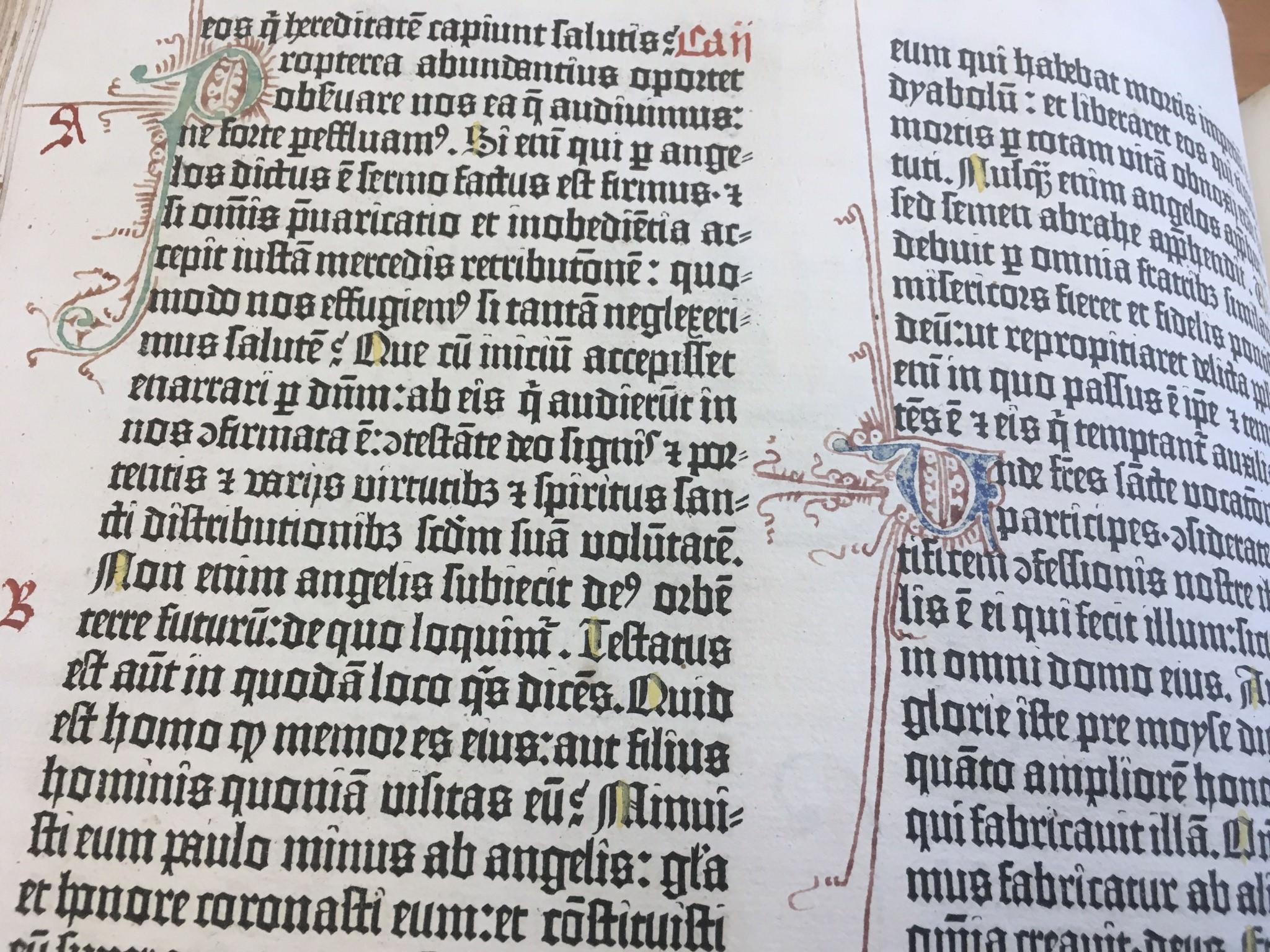
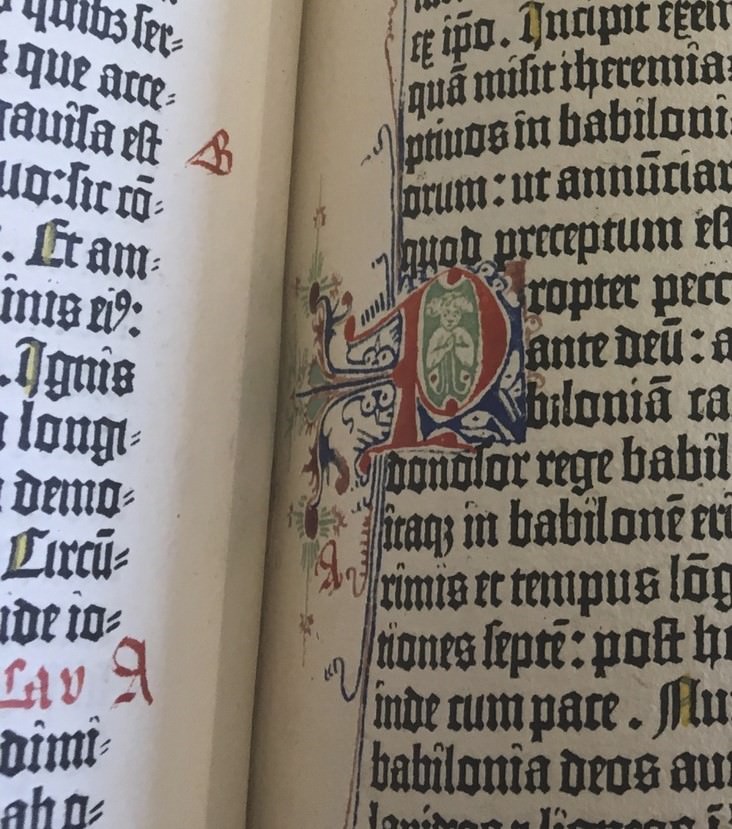
Audubon’s The Birds of America presents me with a different set of challenges. Its images are so widely reproduced, it can be easy to forget they were originally bound in books. Many who will never see the Double Elephant Folio in person will be familiar with the images from framed posters and reprints. Others will have seen Audubon’s birds on playing cards, tote bags, umbrellas, and t-shirts.[v] Encountering the enormous original volumes, one may not immediately recognize them as books at all.
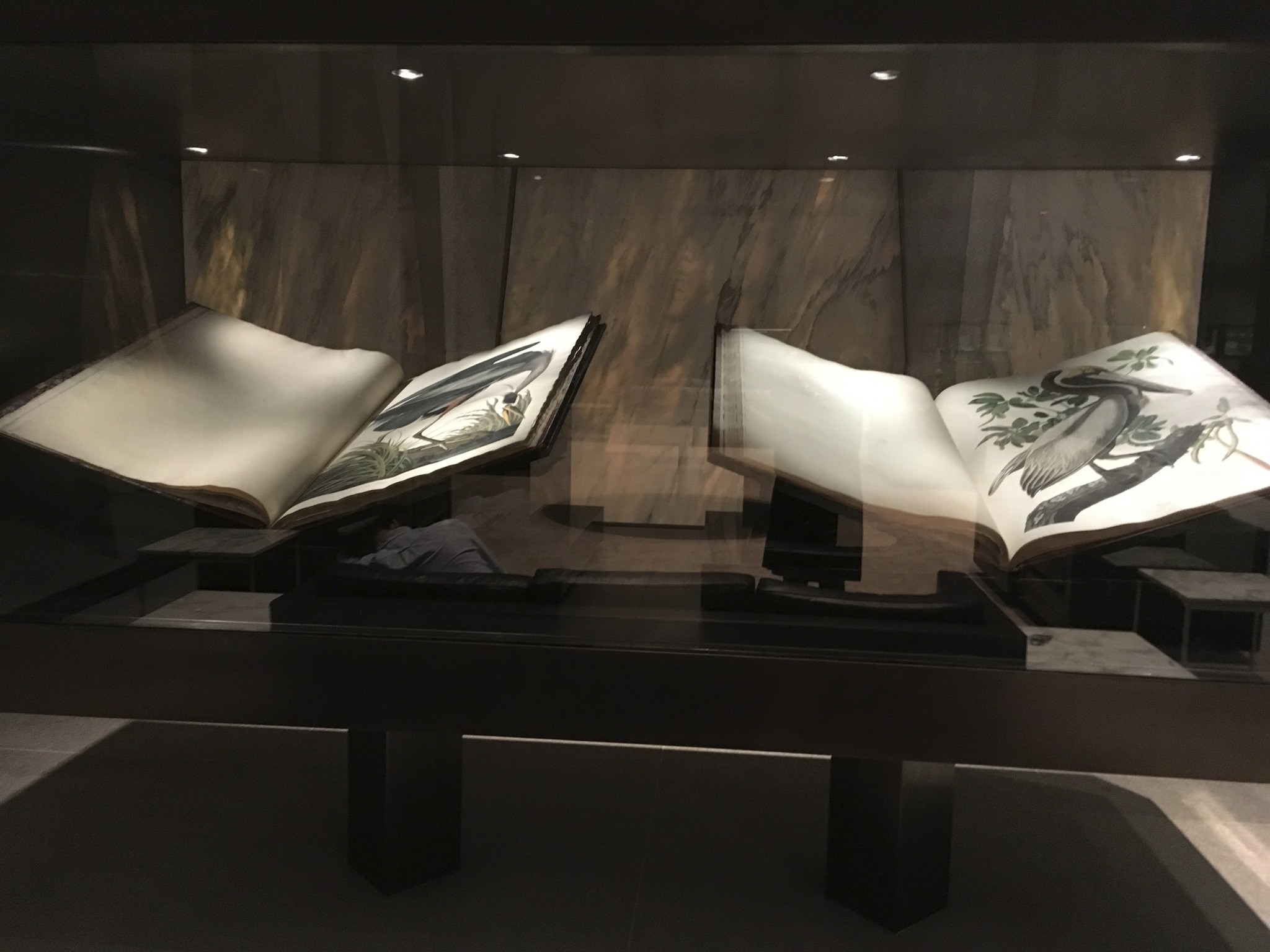
Who’s ever seen such big books? And then—how does one read such books?
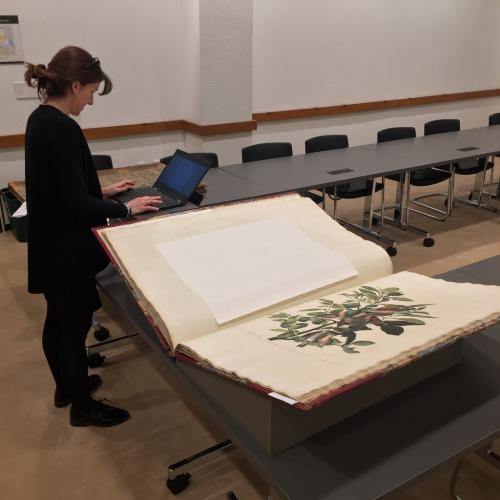
When I became curator of the Beinecke’s Audubon exhibition and requested to see the volumes in one of the Library’s classrooms, it took the efforts of several colleagues to retrieve the books from the stacks; two of my colleagues carried one volume as they might carry a table.[vi] It was difficult for me to imagine turning the book’s pages in any usual way. And, of course, you don’t—turning the pages is a slow and deliberate action, requiring at least two hands; it is possible to feel the weight of the paper, the slight pressure of the air moving against it. Sometime later when I joined an undergraduate class consulting the Double Elephant Folio, two students worked together to turn the pages—one remarked about the unusual, social kind of reading this collaborative handling suggested.[vii]
Because it is an exceptionally beautiful book of what might be rightly understood as fine art prints and because of its tremendous monetary value[viii] we might easily lose sight of one important aspect of The Birds of America. The more than 400 species represented in the book reflect Audubon’s aim to comprehensively depict all the birds found on the continent; the expansive size of the page allowed him to feature each bird—even the long-legged cranes and the great raptors—in true-to-life size. His was to be an authoritative and encyclopedic scientific catalog—itself a goal at least as ambitious as the production of the grand plates. When I first studied the Beinecke’s copies of The Birds of America, I was astonished to find a previous reader’s pencil notations along the bottom edges of several plates marking plate numbers of similar species and the scientific or regional names of some birds.

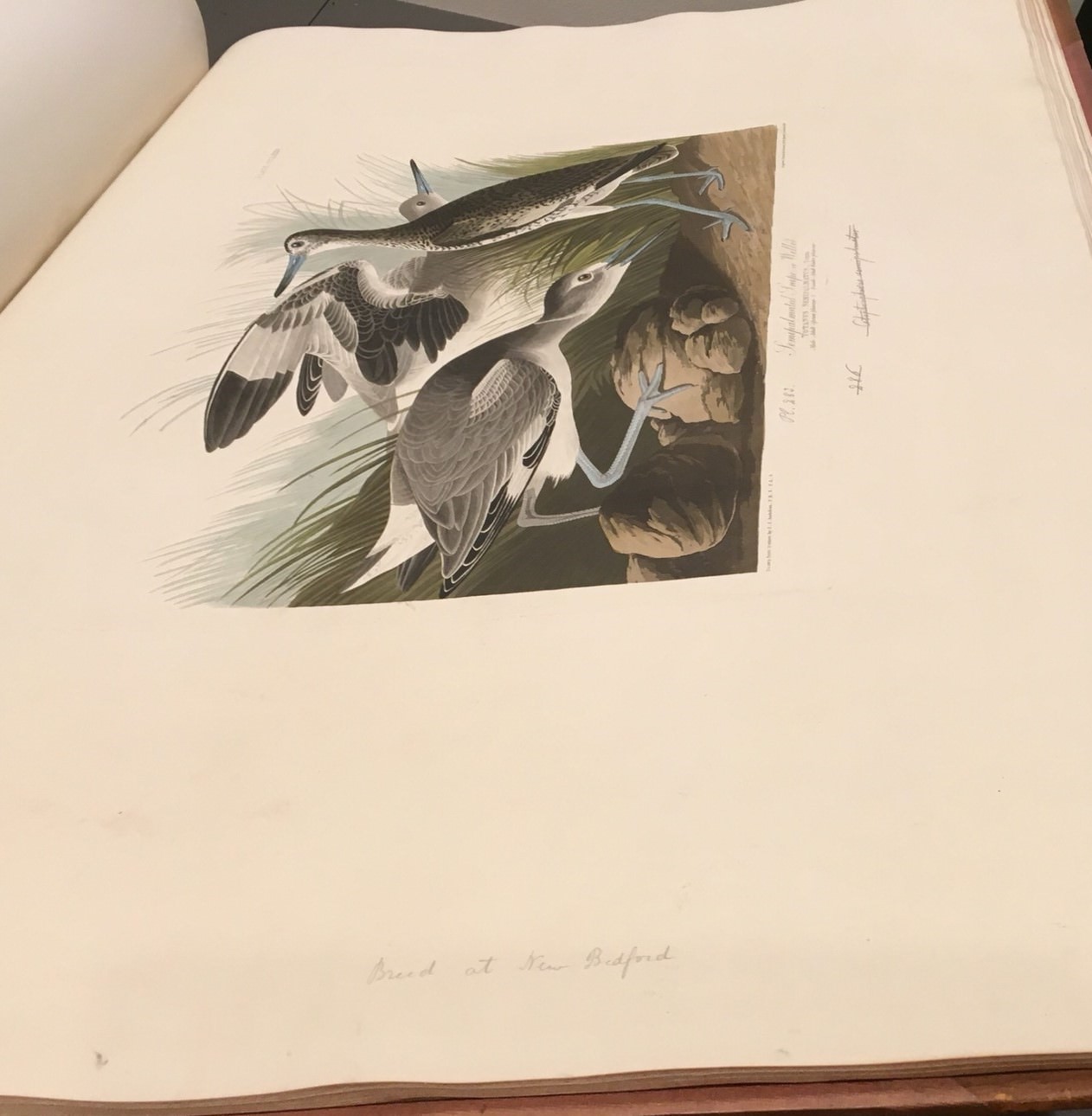
Under the name “Uria Brunnichi” printed on plate 245, the reader had noted “Large Billed Guillemot” (the Audubon Society now identifies this bird as a Thick-billed Murre). In the margin of plate 274, Semipalmated Snipe or Willet, the reader has written: “Breed at New Bedford.”[ix] This long-ago reader’s annotations helped me see clearly one of the original book’s principal functions: enormous and elaborate as it is, The Birds of America served its first readers as a naturalist’s guidebook, a distant descendant of our pocket field identification guides.
Scholars have long studied the Gutenberg Bible and the Audubon Double Elephant Folio—any newcomer to these books can find shelves of scholarship dedicated to understanding the intellectual and aesthetic achievements each represents, detailing their history and context, exploring the aims and ambitions of their makers. Before one approaches this deep body of knowledge, however, the books themselves remind us that that the simple act of looking may qualify as a kind of research and investigation.
[i] Because brief authoritative histories of these works are easily accessible, I do not provide detailed information here.
[ii] The Gutenberg sold for nearly 5 million dollars in 1987 and Audubon for about 12 million in 2010, see: https://www.theatlantic.com/entertainment/archive/2012/01/the-10-most-expensive-books-in-the-world/251828/#slide5.
[iii] The books are consulted in the Beinecke’s classroom and reading room on rare occasions, under special circumstances; the pages of the volumes on permanent exhibition are turned three times a year.
[iv] Since copies of the Biblia Latina were illuminated individually, the images in each existing copy are unique; the copy at the British Library is decorated with songbirds and hawks (see: https://www.bl.uk/collection-items/gutenberg-bible) making this copy a special companion to The Birds of America.
[v] During his lifetime, at least one of Audubon’s images appeared on a woven fabric used to upholster furniture:
[vi] For more on Audubon and furniture, read Erin McCarthy’s essay about The Birds of America and the tables and cabinets designed and built to read and store it: http://mentalfloss.com/article/520325/audubons-birds-america-book-so-big...
[vii] At the Lilly Library, the several-times-a year process of turning the pages of The Birds of America—involving as many as three people--is filmed and posted on Twitter: #FlippingtheBird (see: https://twitter.com/IULillyLibrary/status/972219548312178689).
[viii] It was dear even at the time of its publication--its original subscribers paid about $1,000 for 434 unbound plates and Audubon’s accompanying text, the five volume Ornithological Biography—roughly $25,000 in 2018.
